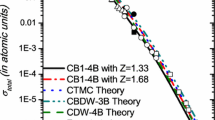Abstract:
The conventional Hartree and Hartree-Fock approaches for treating many-electron bound systems have been extended recently to positive energy scattering problems, in which both the bound and continuum orbitals are determined by the requirement of full self-consistency. Serious consequences of such a theory are that the target orbitals become energy dependent and the asymptotic boundary conditions are satisfied only approximately, in lowest order. It is important therefore to test the theory for its convergence under configuration mixing. This self-consistent field (SCF) theory for scattering has been tested here for scattering from hydrogenic target as a model where the target function is determined dynamically. Penetration of the projectile inside the bound target orbital is manifest through the SCF for the bound state. Our results show that the theory converges to the correct amplitudes and to the exact boundary conditions as more configurations are added. The use of the amputated functions and the weak asymptotic condition (WAC) upon which the SCF theory is based, is justified as the WAC converges to the correct limit. It is then applied to the positron-helium and electron-helium scattering systems where the helium function is calculated simultaneously together with the scattering function. The resulting phase shifts and the SCF target functions are compared with those obtained with the pre-determined target functions in the conventional approaches.
Similar content being viewed by others
Author information
Authors and Affiliations
Additional information
Received 22 September 1999
Rights and permissions
About this article
Cite this article
Zerrad, E., Hahn, Y. Self-consistent field theory of collisions I. Scattering channels. Eur. Phys. J. D 10, 81–97 (2000). https://doi.org/10.1007/s100530050528
Issue Date:
DOI: https://doi.org/10.1007/s100530050528




